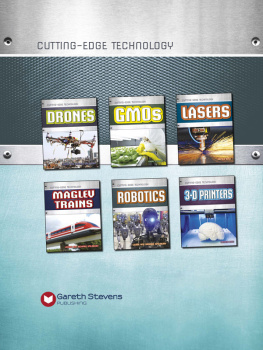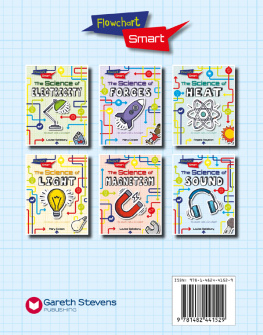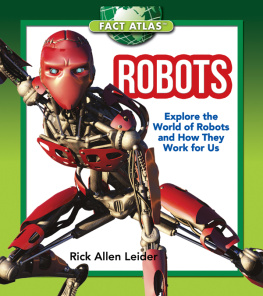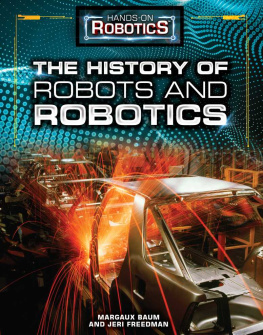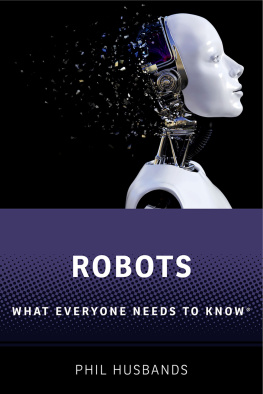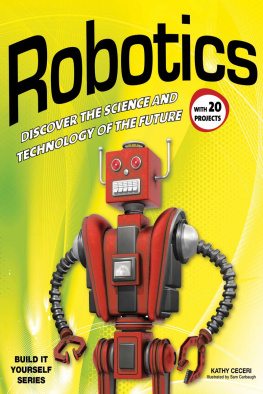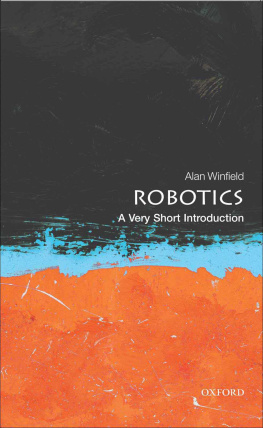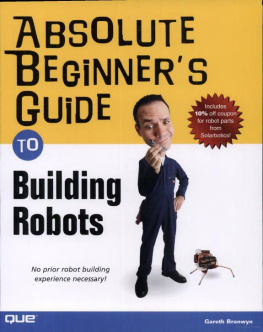Page List

Please visit our website, www.garethstevens.com.
For a free color catalog of all our high-quality books,
call toll free 1-800-542-2595 or fax 1-877-542-2596.
Cataloging-in-Publication Data
Names: Spilsbury, Louise.
Title: Robotics / Louise and Richard Spilsbury.
Description: New York: Gareth Stevens Publishing, 2017. | Series: Cutting-edge technology | Includes index.
Identifiers: ISBN 9781482451665 (pbk.) | ISBN 9781482451603 (library bound) | ISBN 9781482451481 (6 pack)
Subjects: LCSH: Robotics--Juvenile literature.
Classification: LCC TJ211.2 S65 2017 | DDC 629.892--dc23
First Edition
Published in 2017 by
Gareth Stevens Publishing
111 East 14th Street, Suite 349
New York, NY 10003
2017 Gareth Stevens Publishing
Produced for Gareth Stevens by Calcium
Editors: Sarah Eason and Harriet McGregor
Designer: Jessica Moon
Picture researcher: Rachel Blount
Picture credits: Cover: Getty Images: ChinaFotoPress (photo), Shutterstock: Eky Studio (banner), Shutterstock: R-studio (back cover bkgrd); Inside: ARxIUM: 28; EKSO Bionics: 31; ESA: AOES 19; Fullwood Ltd.: Fullwood Merlin 14; Intuitive Surgical: 2009 Intuitive Surgical, Inc. 27; NASA: JPL-Caltech 21; NOAA: Flower Garden Banks National Marine Sanctuary/G.P. Schmahl 33; Shutterstock: Beerkoff 25, Chesky 43, Lonny Garris 9, Nataliya Hora 13, Kajornyot 35, Magicinfoto 45, MilanTomazin 41, Wellphoto 1, 11; Wikimedia Commons: DARPA 7, Sergei Kazantsev (CC-BY-SA-4.0) 5, NASA Ames Research Center 17, NASA/Expedition 39 23, OAR/National Undersea Research Program (NURP); Mass. Institute of Technology 37, Sgt. Sarah Dietz, U.S. Marine Corps 39.
All rights reserved. No part of this book may be reproduced in any form
without permission from the publisher, except by reviewer.
Printed in the United States of America
CPSIA compliance information: Batch #CS16GS: For further information contact Gareth Stevens, New York, New York at 1-800-542-2595.
CONTENTS
R obotics is all about designing, building, and operating robots. It involves the work of specialist engineers who find mechanical, electrical, and electronic solutions to problems in order to make robots for different purposes. Many people think of a robot as a mechanical being that looks a little like a human. However, robots have different shapes and sizes because they are created to do certain jobs.
ROBOTS IN REAL LIFE
Robots are far more than just machines like vacuum cleaners and lawn mowers. Some robots are critical lifesavers. They might be used to carry out surgery in hospitals or to accurately mix up drugs to make medicines. Other robots safely explode hidden bombs or transport dangerous materials. Others are used just for fun!
Industries use robots because they have advantages over human workers. A robot can be programmed to do a routine task over and over without stopping, in exactly the same way and in exactly the same period of time. People become tired or bored doing the same task repeatedly and for long periods. They may make mistakes or risk being injured at work. Robots can also be made from materials that do not get damaged by heat, pressure, chemicals, or sharp or explosive substances.

If they are programmed well, robotic devices can do tasks that usually require human thought. Here, a chess robot takes on several human players at once in Russia!
FIRST ROBOTS
In 1921, a new play opened in Prague, Czechoslovakia, and introduced the word robot to the world. In Rossums Universal Robots by Karel Capek, the robots were mass-produced workers with no feelings. They did the jobs that people did not like to do. In the play, the robots take over the army, do all the jobs, and eventually rule the world!
DEVELOPMENT OF ROBOTS
S ince the time of the ancient Greeks, people have dreamed of tools that carry out tasks without the need for operators. By the fifteenth century, Leonardo da Vinci (14521519) had made sketches of mechanical humans, but it was not until a few centuries later that working automatic machines were first developed.
AUTOMATIC MACHINES
One of the most famous early robot inventors was Jacques de Vaucanson (17091782). He built realistic, life-size models of people that could do things automatically, such as play the flute. His best-known automaton was the digesting duck, which could not only flap its wings, but also eat grain and digest it! Jacques later made machines to automatically weave silk fabric using information stored as patterns of holes on paper rolls.
ROBOTS ARRIVE
In the early 1960s, the first commercial robot started work in factories. Unimate was a robotic arm designed to remove and stack very hot disks of metal used to make cars. The arm was positioned in one place to carry out this one task. People controlled the robot by inputting data into a computer, which sent information to move its parts. Gradually, many types of arms took on more roles in factories. In the 1980s, Honda began to develop robots that looked and moved like humans. ASIMO is its most famous humanoid, or humanlike, robot. It resembles an astronaut 3 feet (1 m) high. This robot can run, walk up and down stairs, pick up and use objects, and respond to voice commands.

Atlas is a 6-foot (1.8 m) humanoid robot that has been engineered and programmed to walk like a human.
CUTTING EDGE
ASIMO can easily fall over if stairs are too steep or if there are more steps than it was programmed to climb. It has difficulty if the ground is not level or it moves too fast. However, the Atlas humanoid robot can move like a real human. It can walk over rough ground without falling. This is because it sees through cameras on its head, senses when it puts a foot down, and automatically adjusts its balance.
ROBOTIC PARTS
R obotic devices can be tiny, such as an insect-sized flying drone, or huge like a giant industrial robotic arm or even a coal-mining machine. However, they share several basic parts that together allow them to function. The simplest way to understand the parts is to think of them like the parts of human bodies.
BODY PARTS
Skeleton: Robots have a frame that suits what they are designed to do. Delicate flying robots might be made from light plastics, but bomb-disposal robots have a thick steel frame.
Muscles: Robots generally have springs, electric motors, or hydraulic rams that act like muscles to make the robots move.
Energy: Most robots that move around have onboard batteries. Some that work in places where replacement batteries are not easy to obtain, such as on Mars, have solar panels that recharge the batteries.
Senses: Sensors on robots allow them to detect the world around them. Many have cameras on board to detect changes in light and shapes with the aid of computers.

